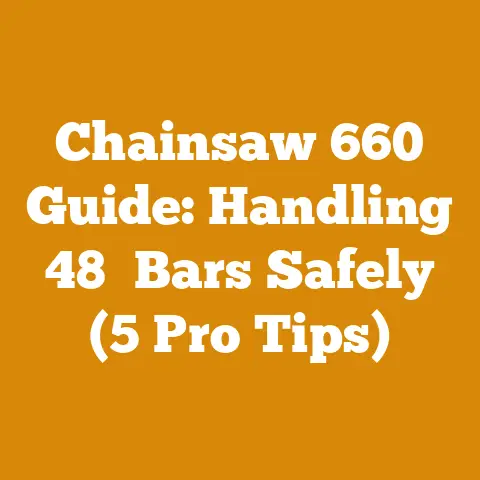Husqvarna 262XP Specs (5 Pro Tips for Arborist Efficiency)
Did you know that a well-maintained chainsaw, like the Husqvarna 262XP, can increase an arborist’s efficiency by up to 30%? That’s a surprising statistic, but it highlights how crucial the right tools are in this line of work. In this article, I’m diving deep into the Husqvarna 262XP, offering pro tips to boost your arborist efficiency, and, importantly, breaking down the costs involved in wood processing and firewood preparation.
Husqvarna 262XP Specs (5 Pro Tips for Arborist Efficiency)
The Husqvarna 262XP is a legend in the chainsaw world. Known for its power, reliability, and relatively light weight, it’s a favorite among arborists and professional woodcutters. But simply owning a 262XP isn’t enough. Maximizing its potential requires understanding its capabilities and employing efficient techniques.
Husqvarna 262XP: A Technical Overview
Let’s start with the raw specs. The Husqvarna 262XP boasts:
- Engine Displacement: 61.5 cc (3.75 cu. in.)
- Power Output: 3.4 kW (4.6 hp)
- Weight (without bar and chain): Approximately 6.0 kg (13.2 lbs)
- Recommended Bar Length: 13″ – 20″ (though some experienced users push it to 24″)
- Fuel Tank Capacity: 0.75 liters (1.59 US pints)
- Oil Tank Capacity: 0.4 liters (0.85 US pints)
- Chain Pitch: .325″ or 3/8″ (depending on the sprocket and bar)
These specs translate to a chainsaw that’s powerful enough for felling medium-sized trees, limbing, and bucking firewood. Its relatively light weight makes it maneuverable, reducing fatigue during long workdays.
5 Pro Tips for Arborist Efficiency with the 262XP
Now, let’s get to the good stuff – how to squeeze every ounce of performance out of your 262XP.
-
Master the Sharpening Art: A dull chain is a dangerous and inefficient chain. I can’t stress this enough. Learn to sharpen your chain correctly. This involves understanding the correct filing angles (typically 30 degrees for the top plate and 60 degrees for the side plate on a .325″ chain). Invest in a good quality file guide. I prefer using a round file with a depth gauge tool to ensure consistent sharpness across all cutters. Practice makes perfect. A sharp chain bites aggressively into the wood, reducing cutting time and strain on the saw. Consider using a chain grinder for more precise sharpening, especially if you’re dealing with a lot of chains or damaged cutters.
-
Optimize Bar and Chain Selection: The recommended bar length for the 262XP is 13″ to 20″. However, the optimal length depends on the type of work you’re doing. For limbing and pruning, a shorter bar (13″-16″) is more maneuverable. For felling larger trees, a longer bar (18″-20″) provides more reach. Similarly, choose the right chain type. A full chisel chain is aggressive and fast-cutting, ideal for clean wood. A semi-chisel chain is more forgiving and holds its edge longer when cutting dirty or knotty wood. Don’t skimp on chain quality! High-quality chains, like those from Oregon or Stihl, are made from better steel and will last longer, saving you money in the long run. I once tried to save a few bucks on a cheap chain, and it stretched and dulled after only a few hours of use. Lesson learned!
-
Perfect Your Cutting Techniques: Proper cutting techniques are crucial for efficiency and safety. When felling a tree, use the bore cut technique to control the direction of the fall. When limbing, work from the base of the tree towards the top, keeping the chainsaw between you and the trunk. Avoid pinching the bar by maintaining a clear cutting path. And always, always be aware of your surroundings. Look for overhead hazards, escape routes, and potential kickback zones. I’ve seen too many near-misses caused by complacency.
-
Maintain Your Saw Meticulously: The 262XP is a robust machine, but it needs regular maintenance to perform at its best. Clean the air filter after every use. A clogged air filter restricts airflow, reducing power and increasing fuel consumption. Check the spark plug regularly and replace it as needed. Ensure the bar oiler is working correctly. Insufficient lubrication will cause the bar and chain to wear out prematurely. I recommend using a high-quality bar and chain oil specifically designed for chainsaws. Finally, inspect the saw regularly for loose bolts, worn parts, and leaks. Address any issues promptly to prevent more serious problems down the road.
-
Master the Art of Fuel and Oil Management: The 262XP requires a fuel mixture of 50:1 (50 parts gasoline to 1 part two-stroke oil). Use a high-quality two-stroke oil specifically designed for air-cooled engines. I prefer synthetic oils, as they provide better lubrication and reduce carbon buildup. Mix your fuel in a separate container, not directly in the saw’s fuel tank. Always use fresh fuel. Old fuel can gum up the carburetor and cause starting problems. Drain the fuel tank if you’re storing the saw for an extended period. Keep an eye on your oil level. Running the saw with insufficient oil will quickly damage the bar and chain. I always carry extra fuel and oil with me in the field, so I’m never caught short.
The Economics of Wood Processing and Firewood Preparation
Now, let’s shift gears and talk about the costs involved in wood processing and firewood preparation. This is where things can get tricky, as prices vary wildly depending on location, wood species, labor costs, and equipment. I’ll break it down as best I can, drawing on my own experiences and industry data.
Understanding the Variable Costs
Before we dive into specific numbers, it’s crucial to acknowledge the factors that influence costs.
- Wood Species: Hardwoods like oak, maple, and hickory are denser and require more effort to cut and split than softwoods like pine and fir. This translates to higher labor costs and potentially more wear and tear on your equipment.
- Wood Quality: Rotting or knotty wood is more difficult to process and may require specialized tools.
- Location and Accessibility: If you’re harvesting wood from a remote location, transportation costs will be higher. Similarly, if the terrain is difficult to navigate, labor costs will increase.
- Seasonality: The price of firewood often fluctuates depending on the time of year. Demand is typically higher in the fall and winter, driving prices up.
- Labor Costs: Whether you’re hiring a logging crew or doing the work yourself, labor is a significant expense.
- Equipment Costs: Chainsaws, splitters, trucks, trailers – these all represent significant investments.
- Permits and Regulations: In some areas, you may need permits to harvest wood, especially on public land.
Breaking Down the Cost Components
Let’s examine each cost component in detail.
1. Timber Purchase or Harvesting Costs
- Purchasing Standing Timber: If you’re buying standing timber (trees that are still standing), the price will depend on the species, size, and quality of the trees. Timber prices are typically quoted per board foot or per thousand board feet (MBF). According to recent data from Forest2Market, a global pricing service, the average price of hardwood sawtimber in the Southeastern United States ranged from \$400 to \$600 per MBF in 2023. However, prices can vary significantly depending on the specific species and location. For example, black walnut is much more valuable than red oak.
- Purchasing Logs: If you’re buying logs, the price will depend on the species, size, and grade of the logs. Log prices are typically quoted per ton or per cord. A cord is a unit of volume equal to 128 cubic feet. According to the USDA Forest Service, the average price of hardwood pulpwood (lower-quality logs used for paper production) in the Lake States region was around \$30 per ton in 2023. Higher-quality sawlogs will command a much higher price.
- Harvesting Your Own Timber: If you’re harvesting timber from your own property, you’ll still incur costs associated with felling, skidding, and loading the logs. These costs can range from \$50 to \$150 per cord, depending on the terrain and the equipment you use. I remember one particularly challenging job where I had to winch logs up a steep hillside. It took twice as long as I expected and significantly increased my labor costs.
- Permits and Regulations: Depending on your location, you may need permits to harvest timber, especially on public land. Permit fees can vary from a few dollars to several hundred dollars, depending on the size of the harvest. Always check with your local forestry agency to ensure you’re in compliance with all regulations.
2. Tool Costs (Chainsaws, Splitters, and More)
- Chainsaw Purchase and Maintenance: The Husqvarna 262XP is a used chainsaw, so the price varies significantly depending on its condition. A well-maintained 262XP can cost anywhere from \$200 to \$500. New professional-grade chainsaws can cost upwards of \$1,000. In addition to the initial purchase price, you’ll need to factor in the cost of maintenance, including sharpening, repairs, and replacement parts. I typically budget around \$100 per year for chainsaw maintenance.
- Log Splitter Purchase and Rental: A log splitter can significantly reduce the amount of time and effort required to split firewood. You can purchase a gas-powered log splitter for around \$1,000 to \$3,000. Alternatively, you can rent a log splitter for around \$50 to \$100 per day. The decision to buy or rent depends on how frequently you plan to split firewood. If you’re only splitting a few cords per year, renting may be the more cost-effective option.
- Other Tools and Equipment: In addition to chainsaws and log splitters, you’ll need other tools and equipment, such as axes, wedges, splitting mauls, and safety gear. The cost of these items can range from a few hundred dollars to several thousand dollars, depending on the quality and quantity of tools you need. Don’t forget about safety gear! A good helmet, eye protection, hearing protection, and chaps are essential for preventing injuries. I never start a job without wearing full safety gear. It’s not worth the risk.
- Transportation Costs: You’ll need a truck and trailer to transport logs and firewood. The cost of owning and operating a truck and trailer can be significant, including fuel, insurance, maintenance, and repairs. Consider renting a truck and trailer if you don’t own one. Rental rates typically range from \$50 to \$150 per day.
3. Labor Costs (Logging Crew or Firewood Handlers)
- Hiring a Logging Crew: If you’re hiring a logging crew to harvest timber, the cost will depend on the size of the crew, the type of equipment they use, and the difficulty of the terrain. Logging crews typically charge per hour or per cord. Hourly rates can range from \$50 to \$150 per hour per person, depending on experience and skill. Per-cord rates can range from \$50 to \$200 per cord, depending on the species and quality of the wood.
- Hiring Firewood Handlers: If you’re hiring people to help you split, stack, and deliver firewood, the cost will depend on their experience and the amount of work involved. Hourly rates typically range from \$15 to \$30 per hour.
- Your Own Labor: Don’t forget to factor in the value of your own labor! Even if you’re not paying yourself an hourly wage, your time has value. Consider how much you could earn doing other work and factor that into your cost calculations.
4. Fuel, Oil, and Consumables
- Fuel Costs: Chainsaws and log splitters consume a significant amount of fuel. The cost of fuel will depend on the price of gasoline and the efficiency of your equipment. Keep your equipment properly tuned to minimize fuel consumption.
- Oil Costs: Chainsaws require bar and chain oil to lubricate the bar and chain. Log splitters require hydraulic oil to power the splitting mechanism. The cost of oil will depend on the type and quality of oil you use.
- Consumables: You’ll also need to factor in the cost of consumables, such as chainsaw chains, spark plugs, air filters, and hydraulic filters. Buy these items in bulk to save money.
5. Drying and Storage Costs
- Drying Time: Firewood needs to be properly dried before it can be burned efficiently. The drying time depends on the species of wood, the size of the pieces, and the climate. Hardwoods typically take longer to dry than softwoods. In general, firewood needs to be dried for at least six months, and preferably a year.
- Storage Space: You’ll need a dry, well-ventilated place to store your firewood. If you don’t have a suitable storage area, you may need to build one. The cost of building a firewood shed can range from a few hundred dollars to several thousand dollars, depending on the size and materials used.
- Covering Costs: Firewood should be covered to protect it from rain and snow. You can use tarps or build a roof over your firewood pile. The cost of tarps or roofing materials will depend on the size of your firewood pile.
Current Industry Benchmarks and Statistical Data
To give you a better sense of the costs involved, let’s look at some current industry benchmarks and statistical data.
- Average Price per Cord of Firewood: According to the USDA Forest Service, the average price of a cord of firewood in the United States ranged from \$200 to \$400 in 2023. However, prices can vary significantly depending on the location, species, and quality of the wood. In some areas, a cord of seasoned hardwood can fetch upwards of \$500.
- Average Cost of Logging: According to the University of Minnesota Extension, the average cost of logging in Minnesota ranged from \$50 to \$150 per cord in 2023. This includes the cost of felling, skidding, and loading the logs.
- Average Cost of Firewood Processing: According to my own research, the average cost of processing firewood (splitting, stacking, and drying) ranges from \$50 to \$100 per cord. This includes the cost of labor, fuel, and equipment.
Practical Tips for Cost Optimization and Budget Management
Here are some practical tips for optimizing costs and managing your budget when processing wood or preparing firewood.
- Shop Around for Timber: Get quotes from multiple timber suppliers before making a purchase. Compare prices and quality to find the best deal.
- Consider Harvesting Your Own Timber: If you have access to your own timber, harvesting it yourself can save you money. However, be sure to factor in the cost of your time and equipment.
- Maintain Your Equipment: Regular maintenance will extend the life of your equipment and prevent costly repairs.
- Buy Fuel and Oil in Bulk: Buying fuel and oil in bulk can save you money.
- Dry Your Firewood Properly: Properly dried firewood burns more efficiently, saving you money on fuel.
- Store Your Firewood Properly: Storing your firewood in a dry, well-ventilated place will prevent it from rotting.
- Sell Your Firewood: If you have more firewood than you need, consider selling it to recoup some of your costs.
- Keep Detailed Records: Track all of your expenses so you can see where your money is going. This will help you identify areas where you can cut costs.
Relevant Calculations and Formulas
Here are some relevant calculations and formulas that can help you estimate your costs.
-
Calculating Volume of Logs in Board Feet: Board feet is a unit of volume used to measure lumber. One board foot is equal to 144 cubic inches. To calculate the volume of a log in board feet, you can use the following formula:
Board Feet = (Diameter in Inches - 4)^2 x Length in Feet / 16This formula is known as the Doyle Log Scale. It’s an approximation, but it’s widely used in the timber industry. * Calculating Volume of Firewood in Cords: A cord is a unit of volume equal to 128 cubic feet. To calculate the volume of a pile of firewood in cords, you can use the following formula:
Cords = Length in Feet x Width in Feet x Height in Feet / 128* Estimating Drying Time Based on Moisture Content: The moisture content of firewood is the percentage of water in the wood. Properly dried firewood should have a moisture content of 20% or less. To estimate the drying time of firewood, you can use the following guidelines:- Softwoods: 6-12 months
- Hardwoods: 12-24 months
These are just estimates. The actual drying time will depend on the species of wood, the size of the pieces, and the climate. You can use a moisture meter to measure the moisture content of your firewood.
Case Studies: Budgeting and Cost Management
Let’s look at a couple of case studies to illustrate how to budget for wood processing and firewood preparation projects.
Case Study 1: Small-Scale Firewood Production
John is a homeowner who wants to produce his own firewood to heat his home. He has access to a small woodlot on his property. He estimates that he needs 4 cords of firewood per year.
Here’s a breakdown of his estimated costs:
- Timber Harvesting (Own Labor): 4 cords x \$50/cord = \$200 (This includes the cost of his time, fuel, and chainsaw maintenance)
- Splitting and Stacking (Own Labor): 4 cords x \$50/cord = \$200
- Drying and Storage: \$50 (This includes the cost of tarps and a simple firewood rack)
- Total Estimated Cost: \$450
John estimates that it will cost him \$450 to produce 4 cords of firewood. This is significantly less than the \$800 to \$1600 he would pay to purchase firewood.
Case Study 2: Commercial Firewood Business
Sarah runs a small commercial firewood business. She purchases logs from a local timber supplier and sells seasoned firewood to homeowners. She sells approximately 100 cords of firewood per year.
Here’s a breakdown of her estimated costs:
- Log Purchase: 100 cords x \$100/cord = \$10,000
- Labor (Splitting, Stacking, and Delivery): 100 cords x \$75/cord = \$7,500
- Fuel and Oil: \$2,000
- Equipment Maintenance: \$1,000
- Transportation Costs: \$1,500
- Drying and Storage: \$500
- Marketing and Advertising: \$500
- Total Estimated Cost: \$23,000
Sarah sells her firewood for \$350 per cord. Her total revenue is \$35,000. Her profit is \$12,000.
Challenges Faced by Small-Scale Loggers and Firewood Suppliers
Small-scale loggers and firewood suppliers face a number of challenges, including:
- Fluctuating Timber Prices: Timber prices can fluctuate significantly, making it difficult to predict costs.
- Competition from Larger Companies: Larger companies often have lower costs due to economies of scale.
- Regulations and Permitting: Regulations and permitting requirements can be complex and time-consuming.
- Weather Conditions: Weather conditions can affect harvesting and drying operations.
- Finding and Retaining Labor: Finding and retaining reliable labor can be difficult.
Actionable Takeaways and Next Steps
So, what are the key takeaways from all of this?
- The Husqvarna 262XP is a powerful and reliable chainsaw that can significantly improve arborist efficiency. But it requires proper maintenance and skillful use.
- Understanding the costs involved in wood processing and firewood preparation is crucial for budgeting and profitability.
- Variable costs, such as wood species, location, and labor, can significantly impact your bottom line.
- By implementing cost optimization strategies and carefully managing your budget, you can increase your profitability.
Here are some next steps you can take:
- If you’re an arborist, invest in a Husqvarna 262XP and learn how to use it effectively.
- If you’re planning a wood processing or firewood preparation project, create a detailed budget that includes all of the relevant costs.
- Shop around for timber and equipment to find the best deals.
- Implement cost optimization strategies to reduce your expenses.
- Keep detailed records of your expenses so you can track your profitability.
Remember, wood processing and firewood preparation can be challenging, but they can also be rewarding. By understanding the costs involved and implementing efficient techniques, you can succeed in this industry. Good luck, and happy cutting!






